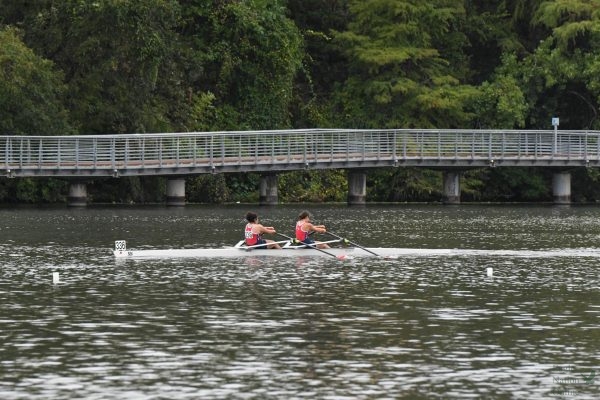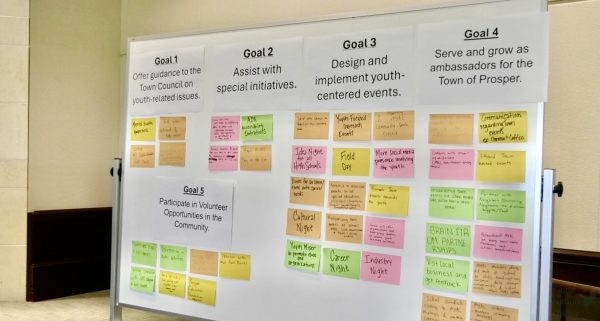Column: A new ‘good’ comes out of the COVID-19 pandemic, possible cut-backs in pollution
Stormy skies travel east, bringing warm weather to the city of Prosper. Now through next week, the weather is perfect for an early morning run, walk or even bike ride – while practicing recommended social-distancing guidelines. According to research done by columnist Caleb Audia, people not using vehicles and other pollution-causing resources while under stay-at-home recommendations may be bringing a positive impact on the environment.
Even though more than 187,000 people worldwide have died from COVID-19, a silver lining may exist: less pollution – even here at home.
In Nov. 2019, a new type of Coronavirus started its outbreak across the world, leading many countries to close borders and act swiftly. Unfortunately, people have taken these precautions too lightly. Today we have more than 2.6 million confirmed cases throughout the globe. Here in Collin County, we have had these stats, according to the county website as of April 22:
- There have been 584 total confirmed positive cases of COVID-19.
- 421 people have successfully recovered; 17 are hospitalized; 132 remain in home isolation.
- There have been 14 confirmed deaths associated with COVID-19.
With many countries in full lockdown and economic depression, the virus has changed the way we all live in less than six months.
In Prosper, cut-back emissions and public health seem to be resting on the horizon.
“From a recreational standpoint, we have fewer people traveling to the parks and or our classes each week,” said Dudley Raymond, Prosper’s Director of Parks and Recreation. “On a positive note, I am noticing what seems like more people walking and cycling.” Ultimately, this shows that even though Collin County issued a “stay-at-home” order, men and women alike are heading outside to cure their boredom and “self-isolation.” The good news: public health is increasing, as people go out for more walks and runs to pass time, decreasing their risk of COVID-19 and increasing their immune systems.
While it’s still not proven that pollution is a direct cause of global warming, many scientists believe that cut-back emissions can improve the health of those stuck in these zones, including animals. Tests and results are still being documented, but it’s safe to say that we are seeing some positive effects of our quarantine habits.
According to a multitude of media outlets, including Climate Matters and ClimateCentral.org sources, the decrease in driving, flying and the burning of gas has lowered the general rate of CO2 emitted. This is leaving clearer skies across the country, especially in southern California. “In Los Angeles, the air quality, which is usually some of the worst in the nation, has turned into one of the cleanest compared to other major cities, according to IQAir,” Gieson Cacho from the Mercury News, said in an article covering polluted cities and the COVID-19 outbreak.
Take, for example, Italy. According to Medical News Today, “Official figures from the Italian government show a significant variation in the lethality of the virus, depending on geographic areas. The researchers suggest that air pollution is a possible factor that could explain this variation.” In many industrial regions, it is shown that the fatality rate of the virus is significantly higher than in other areas. While data continues to be collected, theoretically, it makes sense. Since industrial regions typically contain an abundance of factories, air pollution is expected to be higher than in the surrounding areas.
While you would think that it would be easy to measure the amount of pollution, especially with the reality that counties are on “stay-at-home” orders, it’s more difficult than one might think. For one, the rate of polluted air in an area depends on many factors. These factors include air pressure, temperature, cloud coverage, and even wind speed. Since these conditions are most likely not going to remain the same, the collected data will vary.
Even though it may be hard to determine the actual data and facts, there’s no doubt that public health in these areas is increasing. “The two months of pollution reduction has probably saved the lives of 4,000 children under 5 and 73,000 adults over 70 in China,” Jacinta Bowler from Science Alert said. “That’s significantly more than the current global death toll from the virus itself.”
While the virus is attacking residents’ respiratory systems across the globe, the cut-back emissions and “dropped” pollution rates may be able to help fight the COVID-19 virus. The cut-back emissions are leading areas to improve their breathable air, helping those with respiratory issues, such as asthma, to breathe easier. Because of this, it is hypothesized that less pollution can improve the health of those infected by helping them breathe better.
Health side effects of higher air pollution include: “Aggravated cardiovascular and respiratory illness, stress to the heart and lungs, damaged cells in the respiratory system, accelerated aging of the lungs, and loss of lung capacity and decreased lung function,” according to Spare the Air. All of these side effects, which directly attack the cardiovascular systems, can increase the risk of fatality when infected with COVID-19. That’s why public officials, even amid “stay-at-home” orders, still encourage exercise and public health.
This article updated on June 25 to include a link to Climate Matters and ClimateCentral.org to give readers a better picture of the transportation changes occurring.
Your donation will support the student journalists of Prosper High School. Your contribution will allow us to purchase equipment and cover our annual website hosting costs.

Honors & Awards:
Best of SNO – "Feline friendship, Instagram allows family to help soldier" with Amanda Hare.
Best of SNO – "Junior overcomes dancing accident, bone transplant" with Christi Norris.
Best of SNO – "Podcast: History’s Forgotten – Season 2 – Episode 1 – Charles Whittlesey" with Amanda Hare & Christi Norris.
Best of SNO – "Podcast: History’s Forgotten – Season 2 – Episode 3 – Veterans Day" with Amanda Hare & Christi Norris.
2021 TAJE Honorable Mention – Caption Writing
2021 TAJE Honorable Mention – Story Portfolio
2021 Academic All-State
TAJE Fall Fiesta Honorable Mention – Video News Story "ENN students share common goals, look forward to new season"


















